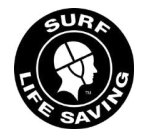(a) The course for IRB competition shall be set at the discretion of the Referee. (See Appendix A).
(b) A “lane” is defined as an area centred on a line of sight from the “beach position marker”, located on the “start/finish line’, and the relative “turning buoy”.
(c) Lanes are bounded by “lane marker” poles (typically red or orange in colour) that are placed in a line parallel to start/finish line and approximately 10 metres from the water edge. These poles form the “changeover line” used for the tag in the teams and relay events. The beach turning markers are placed in the centre of the lane and approximately 5 metres behind the changeover line.
Note: For the IRB Teams Rescue and the IRB Relay events a pole is to be placed directly behind the beach turning marker and is to extend approximately 1.8 metres out of the sand to assist with ensuring the correct changeover procedure.
Alternatively, 1.8 metre high (approximate) beach turning markers may be used for all events.
(d) The turning buoy shall normally be set at a minimum measured distance of 120 metres from the end of knee depth water at the low tide mark and taking into account varying conditions such as sandbars, exclusion of holes and rips, surf conditions, prevailing winds and safety factors.
(e) The “patient pick-up buoy” for the rescue, mass rescue and teams rescue events is positioned approximately 10 metres directly behind the turning buoy.
(f) The “rescue tube patient buoy” for the rescue tube event is positioned approximately 25 metres directly behind the turning buoy.

